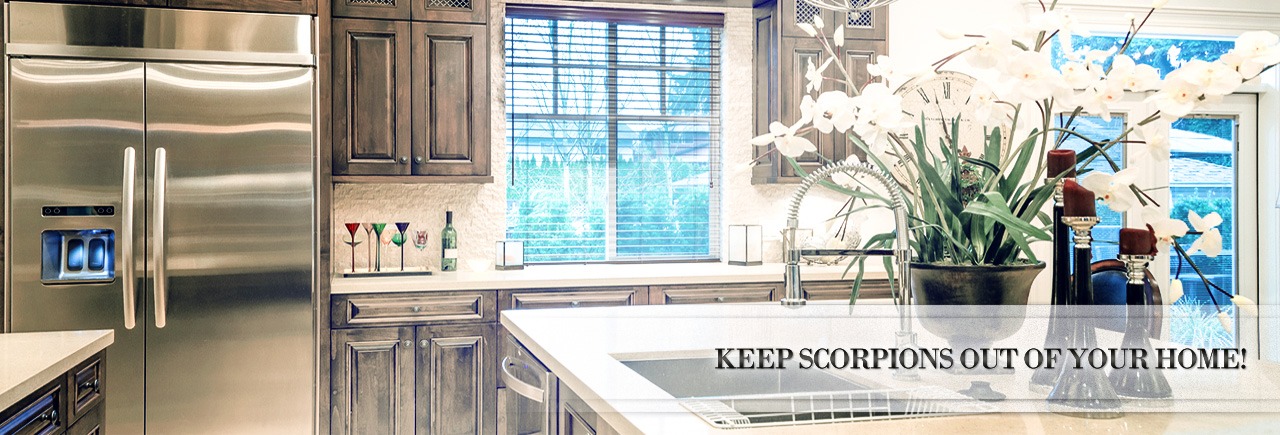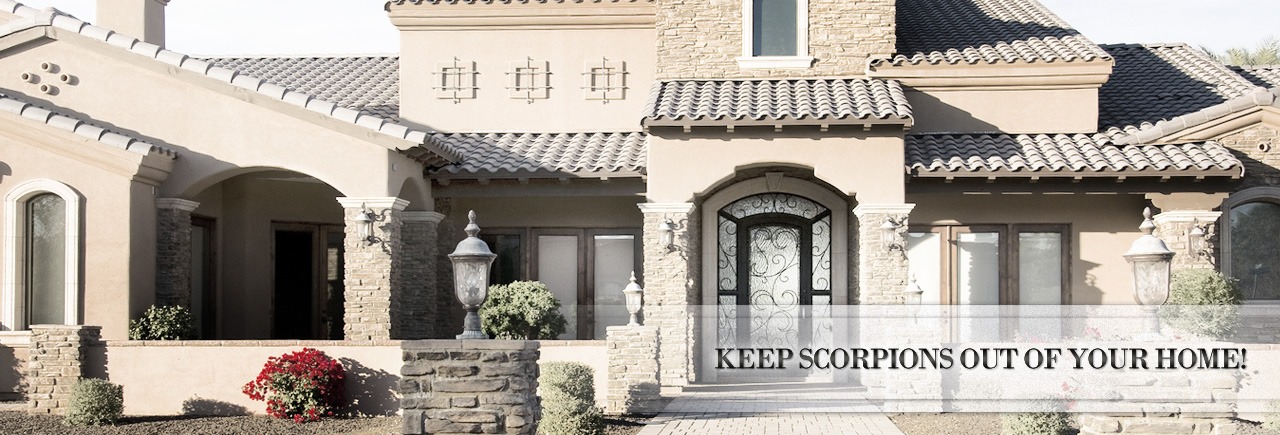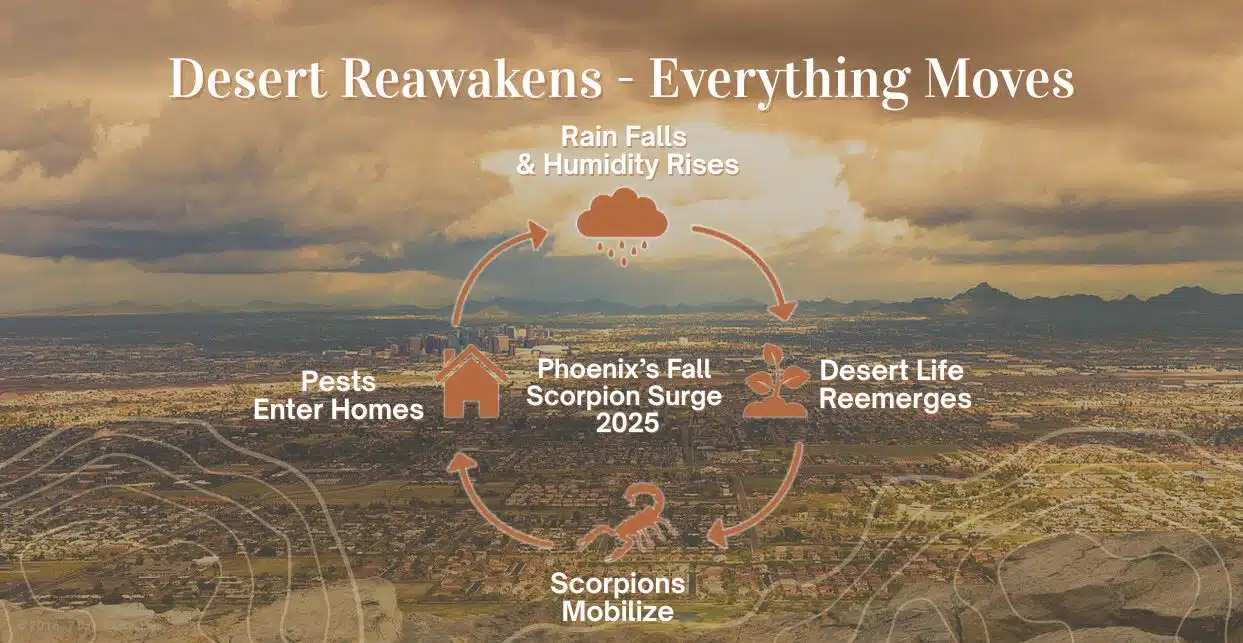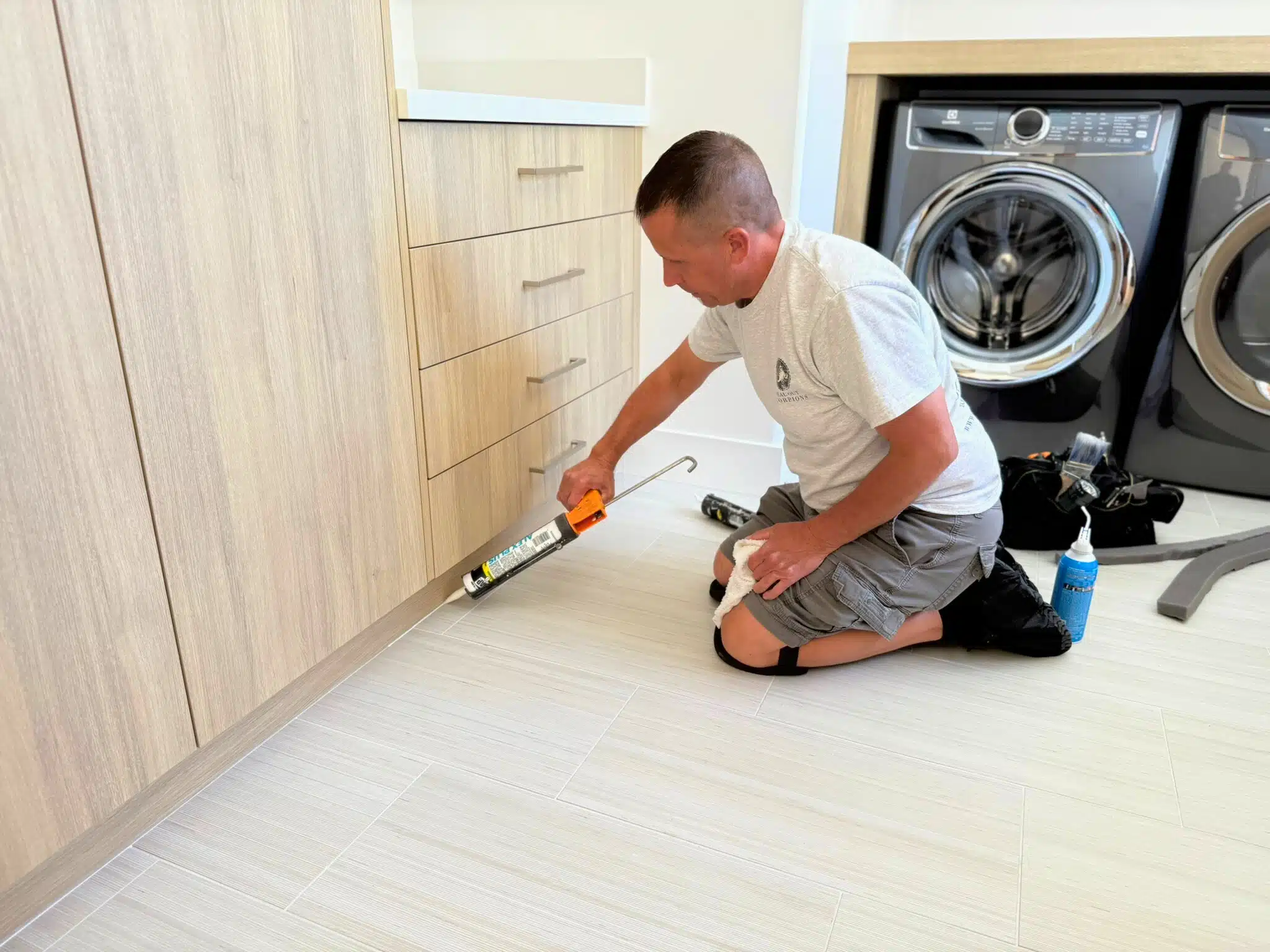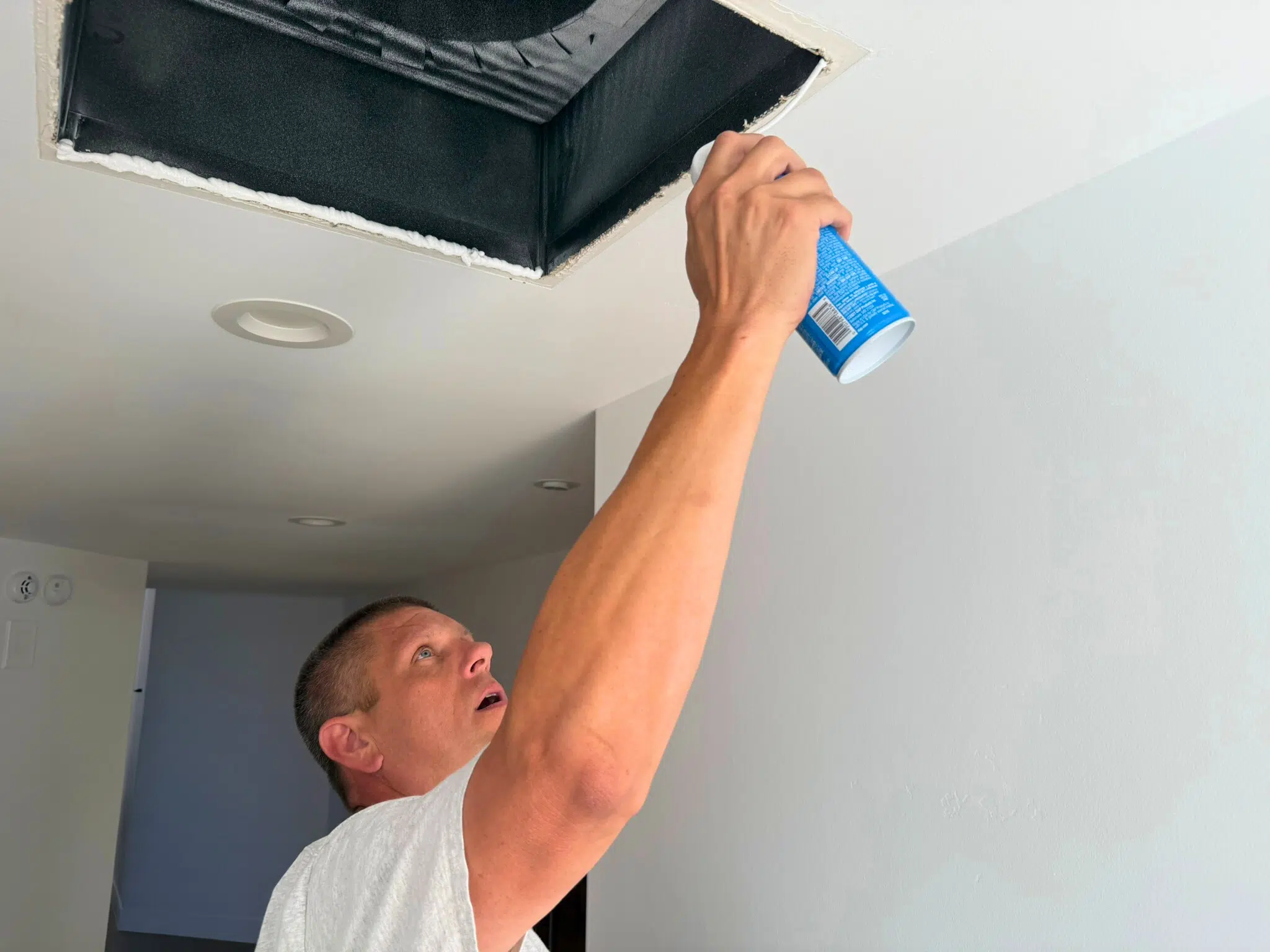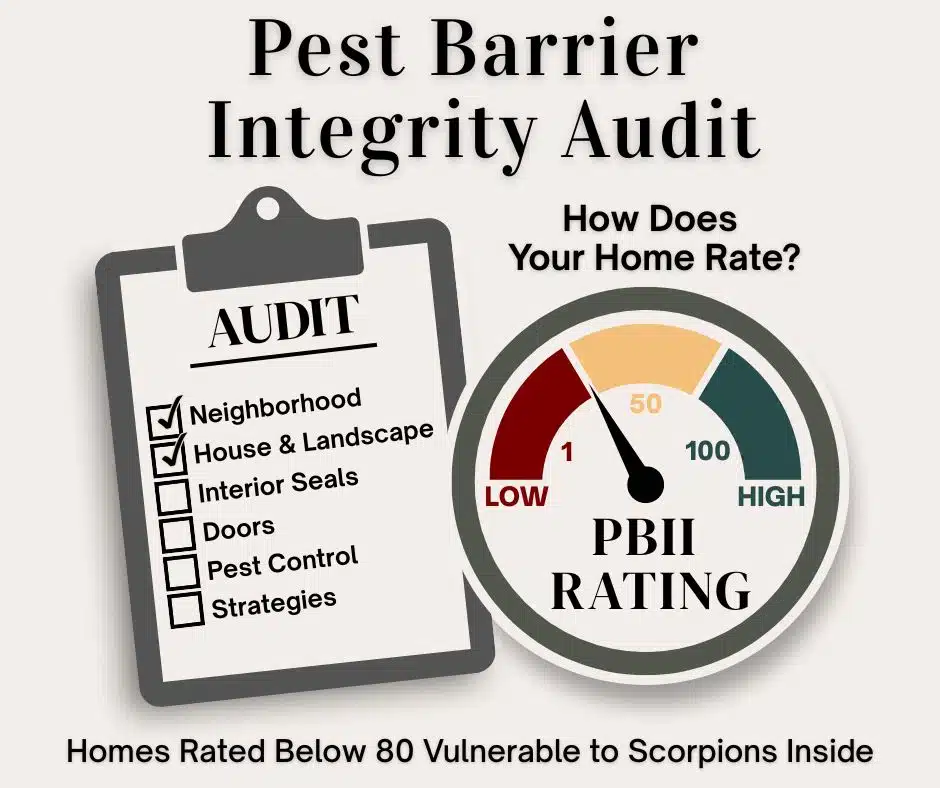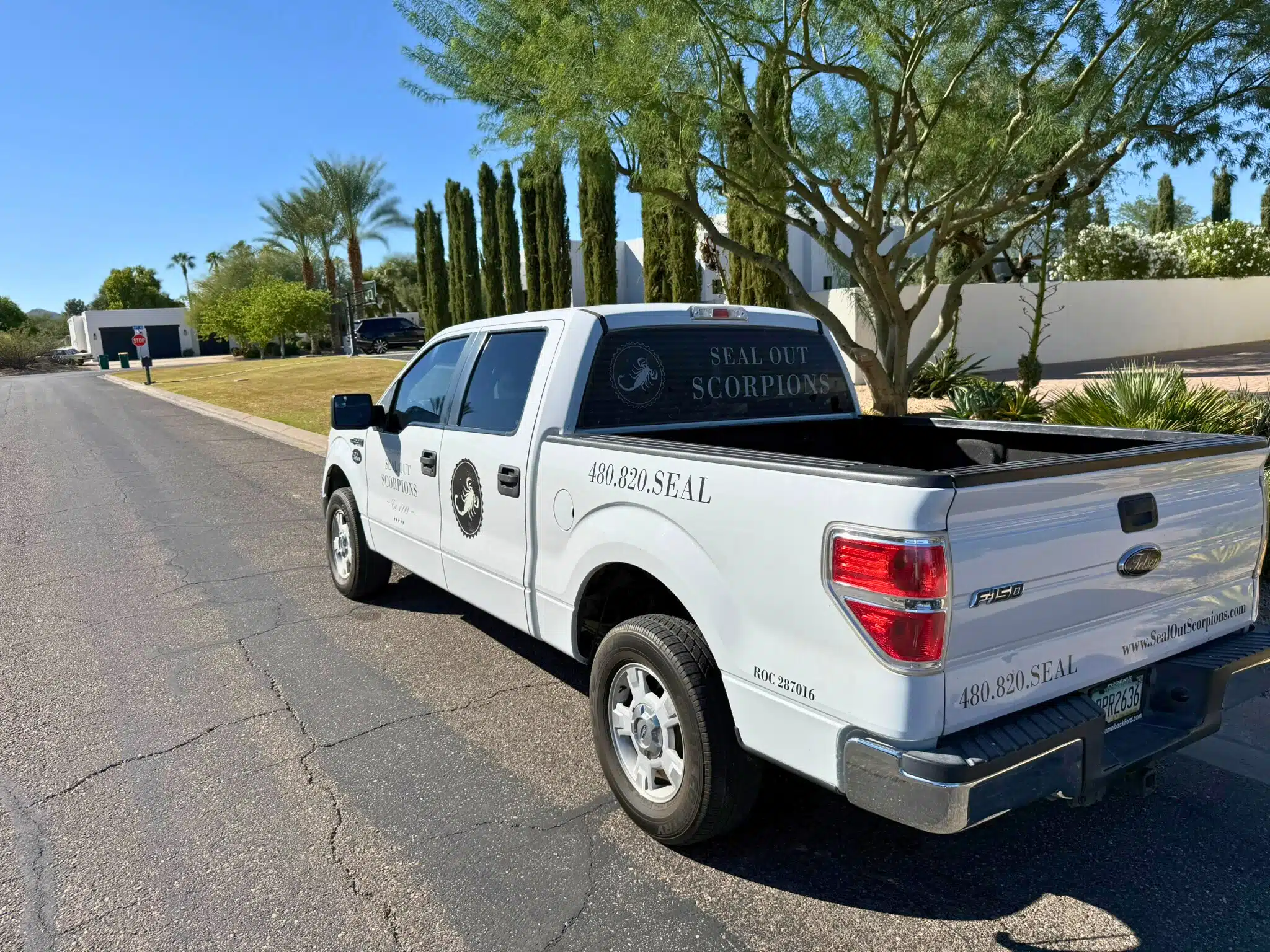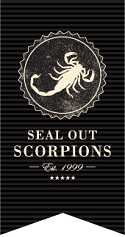Phoenix’s Fall Scorpion Surge (2025): Why They’re Moving Into Homes & How To Stop It Before & During Winter
By Georgia A. Clubb, Advanced Scorpion Specialist, Founder Of Seal Out Scorpions®
Understanding The Surge
If you’re seeing more scorpions this fall, or even into winter, you’re not imagining it. After several years of extreme heat and prolonged dryness, the Phoenix area finally saw a shift in weather patterns, shorter heat waves, higher late-summer humidity, and an unusual burst of fall rain.
While this rain has refreshed desert plants and cooled the evenings, it’s also triggered a resurgence of life across the desert ecosystem, including scorpions. These resilient creatures live for years (not just a single season), so when conditions improve, they become far more active around properties they’ve quietly occupied all along.
Homeowners across Scottsdale, Gilbert, Peoria, and Paradise Valley have all noticed a significant rise in scorpion activity this year, a pattern reflected across the entire Valley.
The Science Behind The Spike
How weather, humidity, and desert ecology converge to drive scorpion movement.
Scorpions are cold-blooded arthropods that depend on environmental cues to regulate their activity. Prolonged drought and relentless heat drive them deeper underground or into cooler micro-habitats to conserve moisture. But when humidity rises and rain softens the soil, they re-emerge to hunt, mate, and relocate.
This fall, Phoenix recorded one of its wettest Octobers in recent memory, following years of rainfall deficits. Those conditions create what’s called a “biological rebound”, when insects, arachnids, and small vertebrates all multiply and mobilize after stress periods.
In short: when nature thrives, so do its survivors.
Bark Scorpions vs. Burrowing Species — The Critical Difference
Not all scorpions behave the same way, and that distinction matters.
Some burrowing species live deep underground in the open desert, creating tunnels to escape temperature extremes. Those species rarely invade homes because their ecology depends on the soil itself.
However, the Arizona Bark Scorpion, the most common home invader and the most venomous in North America, is an arboreal species. That means it’s naturally tree-dwelling, designed to climb and navigate surfaces in search of shelter, food, and mates.
Around Phoenix, our frame-wood and stucco homes mimic ideal tree-like environments. The combination of exterior cracks, framing joints, and attic voids provides superior shelter and more stable micro-climates than natural vegetation ever could.
Scorpions follow airflows and micro-pressure changes, which are abundant around human structures. These air channels guide them toward cooler, more humid spaces, often the voids inside walls, attics, and eaves.
Block walls surrounding most Valley properties act as scorpion superhighways, providing shaded, thermally stable passageways that connect yard ecosystems to home perimeters. Once activity builds near the foundation, scorpions easily locate micro air leaks and follow them indoors.
Why General Pest Control Can Make It Worse
Why “regular spraying” can backfire when it comes to scorpions.
One of the most misunderstood facts about scorpions is that they cannot be exterminated like insects. Their physiology, behavioral patterns, and long life cycles (up to 6–8 years) make them resistant to standard insecticide applications.
In fact, general pest control treatments are one of the main culprits in flushing scorpions indoors. When broad-spectrum insecticides kill off crickets, roaches, and spiders, the scorpion’s natural food supply, it drives hungry scorpions into cooler, safer, and more stable areas. That often means inside your home, where they can be found on ceilings, in furniture, or around eaves searching for prey or shelter.
Scorpions are survivors, not seasonal nuisances. They adjust, relocate, and persist. True prevention requires modifying the structure and surrounding environment, not just the surface layer of pest populations.
Why Scorpions Head Indoors In Fall & Stay Through Warm Winters
Fall is the entry point. A mild winter is the invitation to stay.
Fall in the desert means transition. As nighttime temperatures dip into the 50s and 40s, scorpions start “wintering down.”
That means they search for protected spaces where warmth, moisture, and food sources remain steady, the voids inside and around our homes.
Most modern houses, even new ones, contain hundreds of micro-air leaks, small, unsealed penetrations where electrical, plumbing, or framing gaps create invisible pathways from exterior to interior. These are the same pathways that leak air, dust, and humidity; that scorpions (and other pests) exploit for access and shelter.
When winters are mild, as expected for Phoenix and surrounding cities this year, scorpions may remain semi-active, especially in attics, garages, and wall voids that retain warmth.
Add to that the perfect combination of moisture and warmth from winter lawns, irrigation systems, and foundation landscaping, and you’ve got an open invitation to pests seeking refuge and sustainability.
The Building Science Approach: Sealing & Barrier Integrity
Stopping scorpions begins with fixing the home, not the pest.
Traditional pest control alone can’t solve this. Pesticides degrade over time and do little to stop scorpions from entering. The true defense starts with building performance sealing, addressing the physical structure itself.
Building Performance Sealing™ (BPS) identifies and seals those micro-entry points most pest companies overlook. By combining structural science with prescriptive pest management, we focus on Barrier Integrity, not just barrier chemicals.
This layered approach not only reduces scorpion entry, but also:
- Improves indoor air quality and comfort
- Reduces energy loss through leaks
- Discourages other invaders like rodents, crickets, and spiders that scorpions feed on
It’s the same reason we see fewer callbacks from sealed homes, once a home’s barrier is intact, scorpions simply can’t access the voids they need to survive the winter.
The Pest Barrier Integrity Audit — How Does Your Home Rate?
Every home has a score and it’s measurable.
Every property has a Barrier Integrity Rating, whether you’ve measured it or not.
Our Pest Barrier Integrity Audit™ evaluates your home’s true level of protection: how well your structural envelope prevents pests from entering through unseen air leaks, construction joints, and voids.
Think of it as a home “grade” for pest resistance and building performance combined.
If your home rates low on barrier integrity, scorpions and other pests will find their way in, even if you’ve had regular pest control.
By improving that score, you not only block scorpion access but also increase overall comfort, reduce allergens, and improve HVAC efficiency.
What To Do Before & During Winter
Timing is everything when it comes to scorpion prevention.
Before winter:
- Schedule your Barrier Integrity Evaluation before temperatures cool further. Once scorpions winter down, they’re harder to reach and control.
- Reduce excess moisture around the foundation, winter lawns and over-irrigation create ideal micro-climates for pests.
- Check door seals, weep holes, and utility gaps, even small openings are major pathways.
During a warm winter:
- Stay consistent with Prescriptive Pest Management, scorpions remain semi-active in mild conditions.
- Keep clutter low around foundations and storage areas; it limits harborage points.
- Monitor attics and garages with a flashlight or UV inspection; activity may persist in warmer pockets.
Maintain year-round prevention:
The best protection is not seasonal; it’s systemic. A well-sealed, well-maintained home reduces pest pressure every month of the year.
The Takeaway
This year’s weather has rejuvenated life across the desert, beautiful to watch, but challenging for homeowners. Scorpions are not invading; they’re adapting. The key is to make sure your home isn’t part of that adaptation.
At Seal Out Scorpions, we’ve spent over two decades perfecting a Building Performance Sealing and Prescriptive Scorpion Control system, proven across thousands of Arizona homes.
We don’t just manage scorpions; we engineer their exit.
We treat valleywide, from Scottsdale to Gilbert, Peoria to Paradise Valley, and throughout Arizona and neighboring Southwestern states where scorpion populations are heaviest.
If you’ve noticed increased activity this fall or during our warm winter, now is the time to act before they settle deeper into your home’s structure.
Ask us about a Pest Barrier Integrity Audit™ and find out how your home rates to keep scorpions and other pests out, once and for all.
Before Winter
- Seal early. Schedule a Barrier Integrity Evaluation before temperatures drop. Once scorpions winter down, they’re harder to reach or flush out.
- Dry out foundations. Limit winter lawn irrigation and landscape watering; moisture draws prey and scorpions follow.
- Inspect openings. Check weather-stripping, door sweeps, weep holes, and utility penetrations for micro air leaks.
During a Warm Winter
- Stay proactive. Even in mild winters, scorpions stay semi-active inside attics, garages, and wall voids.
- Continue Prescriptive Pest Management. Periodic exterior service maintains pressure zones that prevent rebound activity.
- Declutter and monitor. Keep storage areas organized; use a flashlight or UV scan around baseboards, ceilings, and eaves.
Year-Round Mindset
A sealed, balanced home defends against pests in every season.
Request a Pest Barrier Integrity Audit™ today to learn how your property rates, and keep your environment sealed, safe, and comfortable all year long.
About Seal Out Scorpions®
Seal Out Scorpions is led by Georgia A. Clubb, Advanced Scorpion Specialist, together with William L. Clubb and Michael C. Golleher — Certified Building Analysts and Envelope Professionals through the Building Performance Institute, with additional Building Science Certificates and studies in Urban & Industrial IPM through Purdue University. Their team includes licensed pest management and sealing specialists who pioneered Building Performance Sealing to solve scorpion problems at the structural level.


